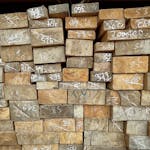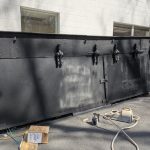Preparing Reclaimed Pallet Wood: Drum Sander vs. Benchtop Planer
When working with pallet wood some folks use the wood “as is.” I generally use pallets as a source of rough lumber that I sand or plane to “like new.” Given that I regularly find pallets made from everything poplar, cherry, oak, and maple, this provides me a free (of out-of-pocket costs) source for wood used in our classes and products.
Two key tools for reclaiming pallet wood are the drum sander and the benchtop wood planer. Let’s explore which one is better suited for stripping down pallet wood to be used as a source for everything from fine furniture to simple crafts.
Drum Sander
- It allows you to remove just a little wood and preserve the thickness of the already thin wood found on pallets.
- Unlike a planer, which can be damaged by embedded nails, the drum sander handles them more gracefully.
- Using the drum sander may require several passes as you a drum sander cannot remove as much wood with each pass as a planner.
- The open-ended design of the drum sander allows you to sand boards wider than a typical planer (which usually has a max width of 13″).
- Dust collection is crucial when using a drum sander.
Drum Sander Recommendation
I recommend the Jet 10” Open Ended Benchtop Drum Sander. This works with no issues at the most affordable option as there are far fewer drum sander offerings than compared to most other workshop tools.
Benchtop Planer
- The benchtop planer is usually less expensive and more readily available with many options tool for quickly smoothing boards.
- A planer removes a thicker amount of wood with each pass than a sander and after you have planed each side you may find the resulting stock to be too thin to be useful.
- You can get by without a dust collection system with a planner.
Benchtop Planer Recommendation
I recommend the DeWalt 13-inch Thickness planer with three knives. At $600 this is a great unit that will not break the bank and can take the beginner well as they become more advanced.
Our Choice at The Makers Hive
At The Makers Hive we process dozens of pallets at a time and may reclaim wood from hundreds of pallets across the year. When I started, I used the planner to get a near virgin finish to the boards. However, after planning both sides of often cupped, curved, and twisted boards, And in the end, I found I still needed to sand the wood since the wood never came out pristine from the planner. The result was that I found the stock to be so thin that I could not use about ¼ of the wood and still needing to sand starting with 100 grit.
Then, I then borrowed a drum sander from a friend. WOW – I was able to remove so much less wood and end up with boards that did not need anything other than finish sanding once items were assembled. This at times has been slower preparation because of multiple passes. But the reduction of later sanding and ability to use far more of the reclaimed pallet wood has been a clear benefit.
This does not mean we have found one tool does it all. We end up using the planner on the thick 2×4 and 2×3 skids. We use the drum sander on the 2 to 6 inch wide thinner floor boards. The combination has enabled us to reclaim a far greater portion than using only a planer. This has also helped with the variety of classes we run with the pallet wood as students do not need to spend as much time sanding.
In summary, both tools have their advantages and if I could only choose one ai would go with the benchtop thickness planer. However, having both in your workshop if you can afford them is an absolute treat and time saver.







Leave a Reply